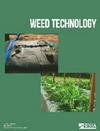Flood Timing and Flood Loss Impact on Effectiveness of Florpyrauxifen-benzyl Coated on Urea in Rice
IF 1.3
3区 农林科学
Q3 AGRONOMY
引用次数: 0
Abstract
Florpyrauxifen-benzyl applications generated complaints and concerns around rice injury and off-target movement to soybean after the commercial launch in 2018. A precise application method for florpyrauxifen-benzyl was imperative for its continued use. Experiments were conducted in 2020 and 2021 to evaluate rice weed control as influenced by preflood application interval and flood loss following florpyrauxifen-benzyl at 30 g ai ha-1 applied as a spray or coated on urea. In the preflood application experiment, coating florpyrauxifen-benzyl on urea and applying it the day of flood establishment, 5, and 10 d prior to flooding (DPTF) resulted in lower yellow nutsedge, broadleaf signalgrass, and barnyardgrass control than when the herbicide was spray at 3 and 5 wk after final treatment (WAFT). Coating florpyrauxifen-benzyl on urea only provided 61 to 63% yellow nutsedge control at 3 and 5 WAFT, which was 35 to 37 percentage points lower than when spray applied at 5 or 10 DPTF. Likewise, rice yields following applications of florpyrauxifen-benzyl coated on urea were 1200 kg ha-1 less than yields following spray applications. Florpyrauxifen-benzyl coated on urea and clomazone provided lower levels of weed control than spraying the herbicide, suggesting an explanation for the yield losses. The timing of flood loss experiment suggested that when florpyrauxifen-benzyl coated on urea at 30 g ai ha-1 was applied preflood and flood was relinquished at 2 hours, 24 hours, and 7 d after flood establishment, hemp sesbania and yellow nutsedge control were not affected. However, loss of floodwater 2 hours after flood establishment resulted in lower barnyardgrass control than when the flood was lost 24 hours and 7 d after flooding. Generally, the period between a herbicide application and flooding completion should be minimized to aid in weed control. These results indicate the importance of maintaining a flood for weed control and nutrient management.洪水时间和洪水损失对水稻尿素中氟吡氧乙酸苄酯效果的影响
氟吡禾草灵苄基醚的施用在2018年商业化推出后,引发了有关水稻伤害和大豆脱靶的投诉和担忧。要继续使用氟吡禾草灵苄基醚,就必须采用精确的施用方法。2020 年和 2021 年进行了实验,评估以 30 g ai ha-1 氟噻草胺喷雾或包衣在尿素上施用氟噻草胺后,水稻杂草控制受水淹前施用间隔和水淹损失的影响。在洪水前施药试验中,将氟吡甲禾灵苄基脲涂在尿素上,并在洪水形成当天、洪水前 5 天和 10 天施药(DPTF),与在最终处理后 3 周和 5 周喷洒除草剂(WAFT)相比,对黄果穗草、阔叶信号草和稗草的控制效果较差。在尿素上涂抹氟吡甲禾灵苄基除草剂,在 3 和 5 WAFT 期只能控制 61% 至 63% 的黄坚果穗草,比在 5 或 10 DPTF 期喷洒除草剂低 35% 至 37%。同样,施用氟吡脲-苄基脲后的水稻产量比喷洒后的产量少 1200 千克/公顷。与喷洒除草剂相比,使用氟吡甲禾灵苄基脲和氯马宗的除草效果较差,这说明了产量损失的原因。洪水损失时间实验表明,在洪水来临前施用 30 g ai ha-1 的氟吡甲禾灵苄基脲,并在洪水形成后 2 小时、24 小时和 7 d 放弃洪水时,麻疯草和黄刺玫的防治效果不受影响。不过,与洪水过后 24 小时和 7 天泄洪相比,洪水过后 2 小时泄洪对稗草的控制效果较差。一般来说,应尽量缩短施用除草剂与洪水结束之间的间隔时间,以帮助控制杂草。这些结果表明,保持淹水对杂草控制和养分管理非常重要。
本文章由计算机程序翻译,如有差异,请以英文原文为准。
求助全文
约1分钟内获得全文
求助全文
来源期刊

Weed Technology
农林科学-农艺学
CiteScore
2.90
自引率
21.40%
发文量
89
审稿时长
12-24 weeks
期刊介绍:
Weed Technology publishes original research and scholarship in the form of peer-reviewed articles focused on understanding how weeds are managed.
The journal focuses on:
- Applied aspects concerning the management of weeds in agricultural systems
- Herbicides used to manage undesired vegetation, weed biology and control
- Weed/crop management systems
- Reports of new weed problems
-New technologies for weed management and special articles emphasizing technology transfer to improve weed control
-Articles dealing with plant growth regulators and management of undesired plant growth may also be accepted, provided there is clear relevance to weed science technology, e.g., turfgrass or woody plant management along rights-of-way, vegetation management in forest, aquatic, or other non-crop situations.
-Surveys, education, and extension topics related to weeds will also be considered
 求助内容:
求助内容: 应助结果提醒方式:
应助结果提醒方式:


